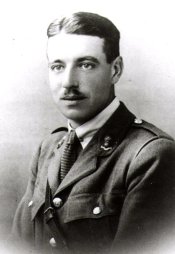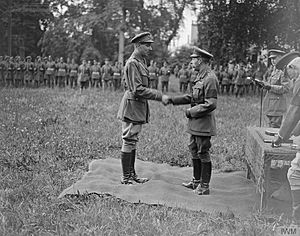Cecil Leonard Knox facts for kids
Quick facts for kids
Cecil Leonard Knox
|
|
|---|---|
 |
|
| Born | 9 May 1889 Nuneaton, Warwickshire |
| Died | 4 February 1943 (aged 53) Nuneaton |
| Buried |
Gilroes Crematorium, Leicester
|
| Allegiance | |
| Service/ |
|
| Rank | Major |
| Unit | Royal Engineers Home Guard |
| Battles/wars | World War I World War II |
| Awards | Victoria Cross |
Major Cecil Leonard Knox was a very brave English soldier. He received the Victoria Cross (VC), which is the highest award for courage given to soldiers in the United Kingdom and Commonwealth countries. He was born on May 9, 1889, and passed away on February 4, 1943.
Contents
Cecil Knox's Family and Early Life

Cecil Knox was born in Nuneaton in 1889. His parents were James and Florence Knox. His family was well-known for their work in engineering, especially with railways. They also owned a large part of the Haunchwood Brick and Tile Company.
Cecil was one of nine brothers. All of his brothers fought in World War I. Some of them also received special awards for their bravery. For example, his brother James Meldrum Knox earned the DSO.
Major Knox's Bravery in World War I
Cecil went to Oundle School when he was younger. When he was 29 years old, he became a temporary second lieutenant. He was part of the 150th Field Company in the Royal Engineers, which is a part of the British Army. This was during World War I.
His incredible act of bravery happened on March 22, 1918, in a place called Tugny-et-Pont in France. Cecil was given a very important and dangerous job. He had to destroy 12 bridges to stop the enemy from advancing.
He successfully blew up most of the bridges. But when he got to one steel bridge, the time fuse he set didn't work. Without thinking twice, he ran to the bridge even though the enemy was firing heavily at him. The enemy soldiers were actually already on the bridge!
Cecil quickly tore away the faulty time fuse. Then, he lit a different, faster fuse. To do this, he had to get underneath the bridge, which was extremely risky. As an engineer, he knew just how dangerous this was. His quick thinking and courage saved the day. For this amazing act, he was awarded the Victoria Cross.
Life After the War
After World War I, Cecil joined the Royal Auxiliary Air Force. He had a serious accident while parachuting during this time.
When World War II began, he joined the Home Guard. He reached the rank of major. Sadly, he passed away on February 4, 1943, after a motoring accident.
See also
- William Neilly

